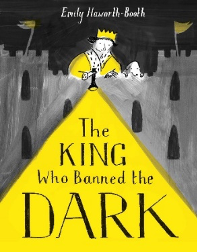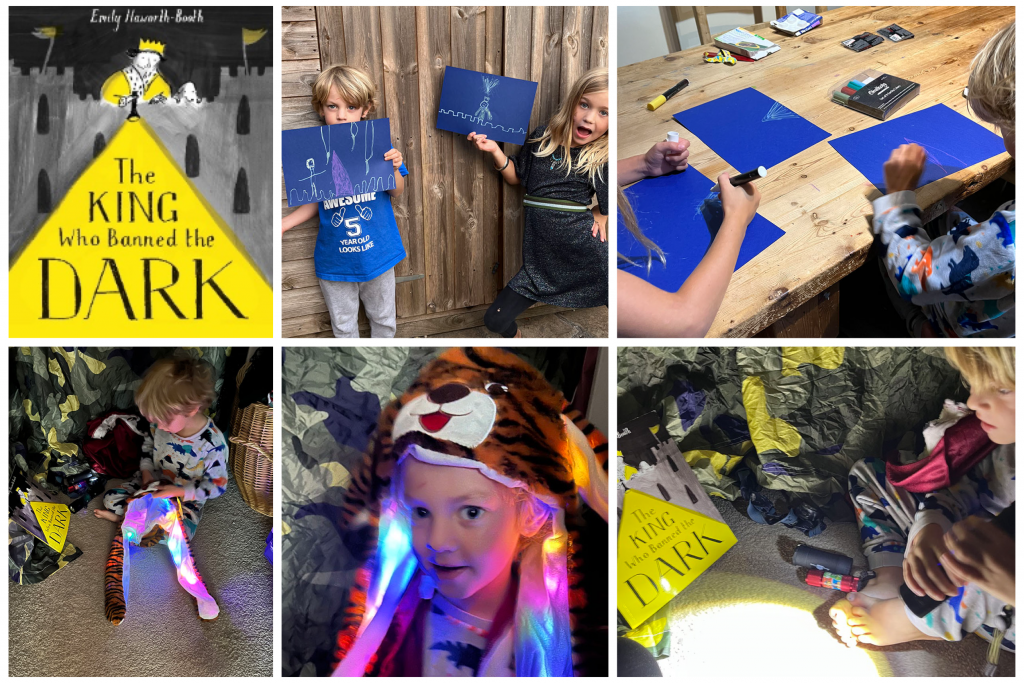 Emily Haworth Booth
Emily Haworth Booth
Pavilion
Age 5-7+
This is a story of a little boy who was afraid of the dark. Not so unusual you may think, but this little boy is a prince who decides that when he becomes king, he will actually ban the dark. This story explores what happens when, helped by his advisors, he tries to do just that.
This is a clever, engaging story which encourages readers to think about the importance of periods of darkness in our lives and also how power might be used, abused or resisted. The predominantly yellow and black colour scheme emphasises the artificially created permanent day time in the story and contrasts with the colourful burst of fireworks at the end of the book.
Share the story
Read aloud
As you read the book aloud pause occasionally to think together about what is happening. For example, you could pause after the first two double page spreads to consider how the king could ban the dark. Pause again to look at the page where people are celebrating all night, think about what you see in the pictures and what might happen next – will people just go on celebrating? What problems might there be?
Join in
When children are familiar with the story it would be fun for them to join in with the voices of the advisors. You could make up extra conversations too. Children developing independence as readers could read alternate pages or lines with you.
Talk more about the story
-
Talk about unfamiliar words and ideas eg ban, rumour, reign, revolt, banished, artificial
-
Discussing the rumours might lead to a discussion of fake news – eg the suggestion that the dark is stealing your money
-
Think together about what the king tried to do. Should he have done this? What advice would your child have given to the young king about his plan?
-
Talk about why people are often afraid of the dark and the sort of things that can reassure or help.
Things to make and do
Play the story
-
Together you could role play a scene from the story with one of you being the king and the other one of the advisors.
-
You could set up and imaginary newsroom and your child could pretend to be a reporting news from the palace that the dark is going to be banned and why.
-
You could have an imaginary interview with one of you as a reporter and the other a member of the public talking what it’s like now that dark has been banned.
Design an anti-dark hat
Children could create their own design for an anti-dark hat. They could think about what they might use and how it could work and label their design.
Make a dark and light picture
Your child could make their own dark and light picture using black and yellow – charcoal would be perfect for this or black crayon with yellow pastel, crayon or paint for the light. They could draw a scene from the story or their own idea.
Experiment with torches
Create a dark space with curtains drawn and the lights off or a blanket over a table and shine a torch to look at the shape of the light and patterns you can create.
Write a news report
Your child could write their own imaginary news report about what happens when the dark is banned. Think up a headline together eg ‘We Need the Dark Back Say the People’. Your child could add their own drawing as if it is a photograph. Here is a template you could use.
Play a game
Use the opportunity of a larger gathering of family or friends to play Chinese whispers – a great way to introduce the idea of how rumours might spread. Start this off by making up a message and whispering it into the ear of someone else in the group – they pass the message on in the same way until everyone has heard the message. The last person then says what they heard out loud. Has the message changed? This is more fun with a group of 6 or more.
Find out more
-
Find out more about the book’s creator
-
The publisher’s website includes additional activity resources based on the book
-
Use the internet or information books to find out about places in the world where at times in the year the sun doesn’t set eg North Norway.



 Follow lovemybooksUK15
Follow lovemybooksUK15